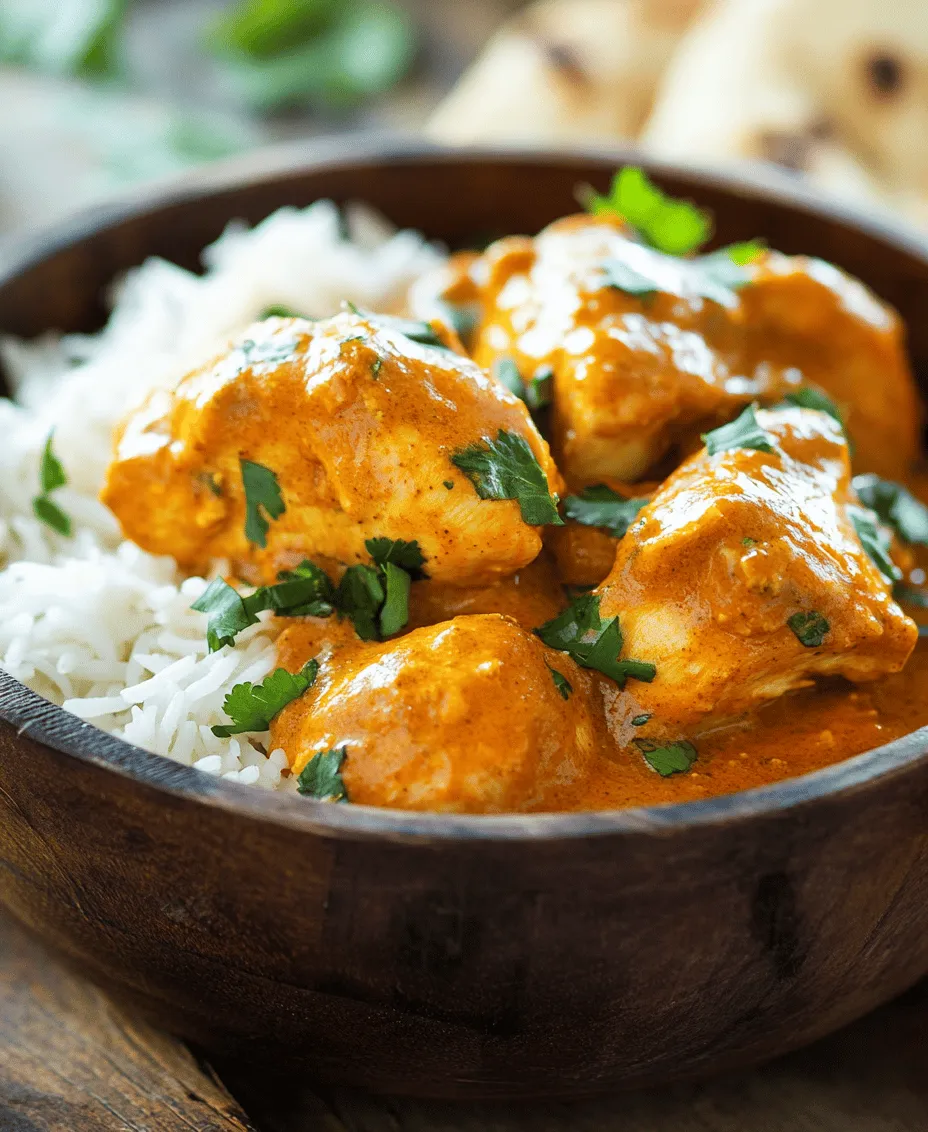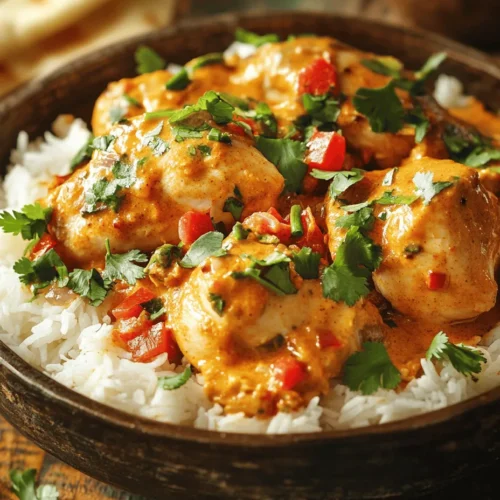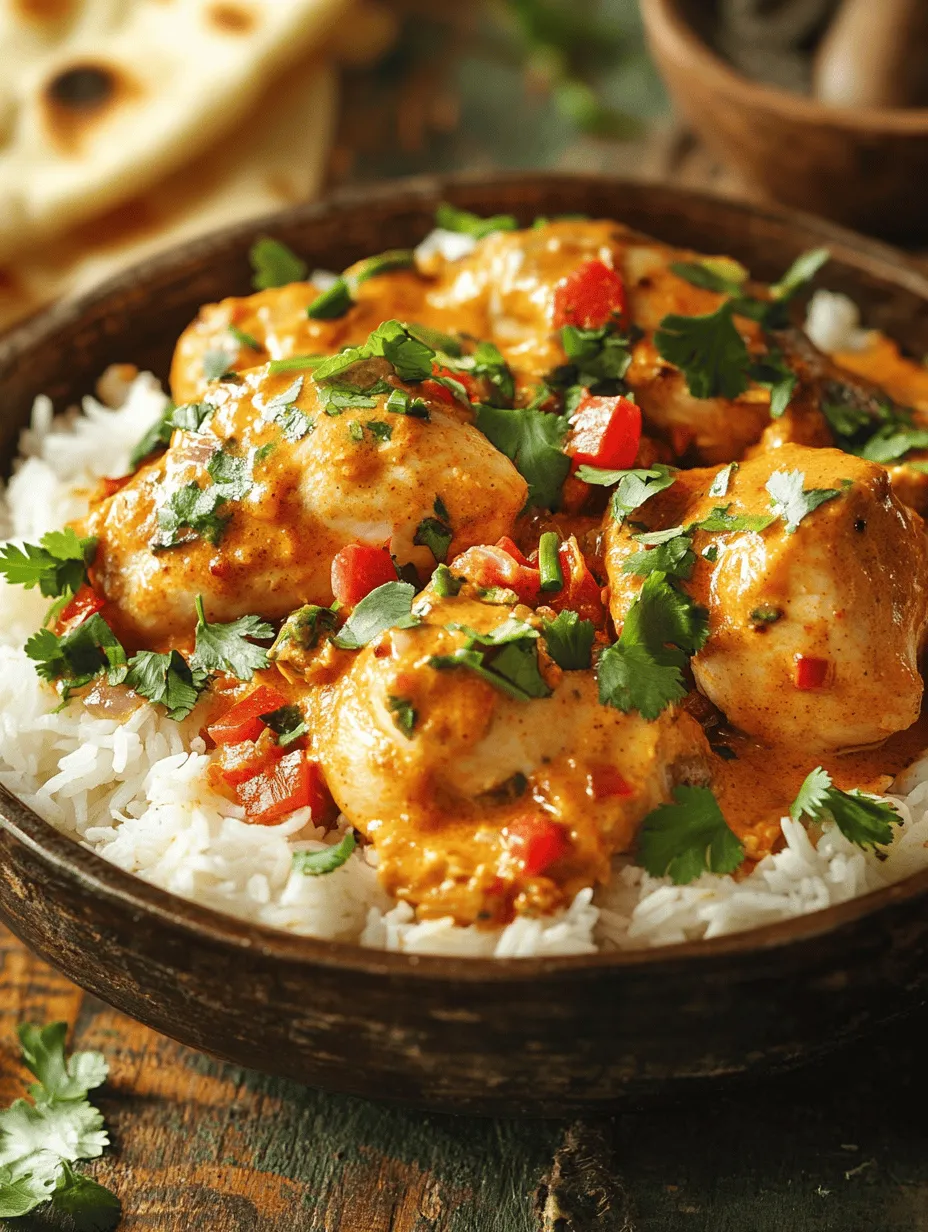Introduction
Chicken Tikka Masala is not just a dish; it’s a culinary phenomenon that represents the harmonious blend of Indian and British cuisine. This vibrant and flavorful dish has captured the hearts and palates of food lovers around the world, making it a staple in many households. It’s a delightful showcase of spices, marinated chicken, and a creamy tomato sauce that’s rich in flavor, comforting, and undeniably delicious.
Among the many renditions of Chicken Tikka Masala, Gordon Ramsay’s version stands out, inviting home cooks to experience the depth of Indian cooking with a flair of modern culinary techniques. His recipe enhances the traditional elements of this dish while ensuring that it remains approachable for anyone, regardless of cooking experience. By following Ramsay’s guidance, you can elevate your cooking game and impress your family and friends with a meal that is both authentic and sophisticated.
In this article, we will embark on a flavorful journey to master Gordon Ramsay’s Chicken Tikka Masala, exploring its origins, the essential ingredients, and the preparation process that will bring this incredible dish to life in your own kitchen.
The Essence of Chicken Tikka Masala
To truly appreciate Chicken Tikka Masala, one must delve into its fascinating origins. While the dish is often associated with Indian cuisine, its creation is believed to have taken place in the UK. The origins of Chicken Tikka date back to Indian culinary traditions, where marinated pieces of chicken are skewered and grilled. However, the creamy tomato-based sauce that characterizes Chicken Tikka Masala is thought to have emerged as a result of adapting traditional recipes to suit Western palates.
This fusion dish gained immense popularity in the UK during the 1960s and 1970s, coinciding with the rise of Indian restaurants across the country. It quickly became a favorite among locals, who appreciated the balanced flavors and comforting nature of the dish. Today, Chicken Tikka Masala is often referred to as a “national dish” of Britain, symbolizing the multicultural culinary landscape that defines modern British cuisine.
What makes Chicken Tikka Masala unique compared to other curries is its double-layered flavor profile. The marinated chicken, grilled to perfection, is infused with spices, while the creamy sauce adds a luxurious texture that complements the meat beautifully. The combination of spices, yogurt, and cream creates a dish that is both vibrant and comforting, making it a favorite for dinner parties and family meals alike.
Ingredients Breakdown
In order to recreate Gordon Ramsay’s Chicken Tikka Masala, it is essential to gather the right ingredients. Each component plays a significant role in building the dish’s rich flavor profile and ensuring that the final result is nothing short of spectacular.
Chicken Thighs
The backbone of any great Chicken Tikka Masala is the chicken itself. Gordon Ramsay’s recipe calls for chicken thighs, which are favored for their rich flavor and tenderness. Unlike chicken breasts, thighs contain more fat, which keeps the meat juicy during cooking. This is crucial, especially when marinating and grilling the chicken, as it ensures that the meat remains moist and flavorful throughout the cooking process.
Marinade Components
The marinade is where the magic begins. The combination of yogurt, lemon juice, and a blend of spices is key to tenderizing the chicken and infusing it with flavor.
– Yogurt: Acts as a tenderizer due to its acidity, which breaks down the proteins in the chicken, resulting in a more succulent piece of meat. Additionally, it adds a slight tanginess that complements the spices.
– Lemon Juice: Enhances the flavor profile with its bright acidity while further aiding the marination process.
– Spices: Common spices used in the marinade include cumin, coriander, turmeric, and garam masala. These spices contribute warmth, depth, and complexity to the dish, transforming simple chicken into an aromatic delight.
Cooking Essentials
Once the chicken is marinated, it’s time to build the flavor base for the sauce. This involves cooking down essential aromatics:
– Onions: Finely chopped onions are sautéed until they are golden brown, providing a sweet, caramelized flavor that serves as the foundation of the sauce.
– Garlic and Ginger: Both garlic and ginger are crucial in Indian cooking, adding pungency and warmth that enhance the overall flavor.
– Chilies: For those who enjoy a bit of heat, adding fresh or dried chilies to the mix can elevate the dish, giving it that signature spicy kick.
Tomatoes and Cream
The combination of pureed tomatoes and cream is what gives Chicken Tikka Masala its signature richness and smooth texture.
– Tomatoes: Used in either chopped or pureed form, tomatoes provide acidity and sweetness, balancing the spices and creating a luscious sauce.
– Cream: Adding cream towards the end of cooking enriches the sauce, making it velvety and luxurious. This creamy element is what sets Chicken Tikka Masala apart from other curries, providing a comforting finish that pairs perfectly with the spiced chicken.
Garnishes and Accompaniments
To complete the dish, garnishing is essential. Fresh cilantro adds a burst of freshness, while traditional sides like basmati rice and naan bread provide the perfect vessels for soaking up the flavorful sauce. These accompaniments not only enhance the dining experience but also help to balance the rich flavors of the Chicken Tikka Masala.
Preparation Process
Now that we have a thorough understanding of the ingredients, let’s dive into the step-by-step guide for preparing Gordon Ramsay’s Chicken Tikka Masala. This methodical approach will help you achieve the best results, ensuring that each component comes together seamlessly.
Step 1: Marinate the Chicken
Start by preparing the marinade for the chicken. In a large bowl, combine yogurt, lemon juice, and a blend of spices, including cumin, coriander, turmeric, and garam masala. Mix until well combined.
Cut the chicken thighs into bite-sized pieces and add them to the marinade. Make sure each piece is well-coated. Cover the bowl and refrigerate for at least 1 hour, allowing the flavors to penetrate the meat. For optimal flavor, marinate overnight if possible.
Step 2: Grill the Chicken
Preheat your grill or a grill pan over medium-high heat. Once hot, remove the chicken from the marinade, allowing excess marinade to drip off. Grill the chicken pieces for about 4-5 minutes on each side, or until they are cooked through and have a nice char. Remove the chicken from the grill and set aside.
Step 3: Sauté the Aromatics
In a large pan or skillet, heat some oil over medium heat. Add the finely chopped onions and sauté until they turn golden brown, stirring occasionally to prevent burning. This process should take about 8-10 minutes.
Once the onions are caramelized, add minced garlic, grated ginger, and chopped chilies. Sauté for an additional 2-3 minutes until fragrant.
Step 4: Build the Sauce
Add the pureed tomatoes to the pan, stirring to combine with the aromatics. Allow the mixture to simmer for about 10 minutes, letting the flavors meld together.
Afterward, lower the heat and stir in the cream, mixing until well incorporated. The sauce should become creamy and rich in color.
Step 5: Combine Chicken and Sauce
Finally, add the grilled chicken pieces into the sauce, ensuring each piece is coated in the luscious mixture. Simmer for an additional 5-10 minutes, allowing the chicken to soak up the flavors of the sauce.
By following these steps, you are well on your way to creating Gordon Ramsay’s Chicken Tikka Masala, a dish that promises to bring the vibrant flavors of Indian cuisine right into your home kitchen. Stay tuned for the final touches and serving suggestions to elevate your culinary experience even further.

Marinating the Chicken
The marination process is crucial for infusing the chicken with rich flavors and ensuring it remains tender and juicy during cooking. Start by combining yogurt, lemon juice, garlic, ginger, and the specified spices (including garam masala, cumin, coriander, and turmeric) in a large bowl. The acidity from the yogurt and lemon juice helps to break down the proteins, making the chicken more flavorful and tender.
For the best results, it’s recommended to marinate the chicken for at least 2 hours, but ideally, you should let it sit overnight in the refrigerator. If time permits, longer marination allows the spices to penetrate deeper into the meat, resulting in a more vibrant flavor. When marinating, ensure that the chicken pieces are well-coated in the mixture. Cover the bowl with plastic wrap or transfer the chicken to a resealable plastic bag to minimize exposure to air, which can degrade the marinade.
Cooking the Chicken
Once the chicken has marinated, it’s time for the next step: cooking. Preheat a large skillet or pan over medium-high heat and add a tablespoon of vegetable oil. The key to achieving a beautifully seared chicken is to ensure that the pan is hot enough before adding the chicken. This helps to lock in the juices and creates a nice golden-brown crust.
Carefully place the marinated chicken pieces in the hot skillet, making sure not to overcrowd the pan. If necessary, do this in batches to maintain the heat of the pan. Allow the chicken to sear without stirring for about 3-4 minutes on each side until it develops a deep, golden-brown color. This browning process is essential for depth of flavor, as it adds a layer of complexity to the dish. Once seared, remove the chicken from the pan and set it aside.
Creating the Sauce
In the same skillet, add a bit more oil if needed, and lower the heat to medium. Start by adding finely chopped onions, and sauté them until they become translucent and fragrant, which usually takes about 5-7 minutes. Next, incorporate minced garlic and ginger, cooking for an additional 1-2 minutes. This step builds the foundation of flavors for your sauce.
Once the onions, garlic, and ginger are well-cooked, it’s time to add the tomatoes. You can use canned diced tomatoes for convenience or fresh tomatoes if you prefer. Cook down the tomatoes for about 10 minutes, stirring occasionally, until they break down and the mixture thickens. This step is crucial, as it concentrates the flavors and creates a rich base for your Chicken Tikka Masala.
After the tomatoes have cooked down, sprinkle in the remaining spices—coriander, cumin, and garam masala—allowing them to bloom in the hot mixture for a minute. This enhances their flavors and releases their aromatic oils, making your sauce even more fragrant.
Combining Ingredients
Now that your sauce is ready, it’s time to combine it with the chicken. Return the seared chicken pieces to the skillet, stirring them into the sauce until they are thoroughly coated. At this point, add coconut milk or heavy cream to achieve that signature creamy texture that Chicken Tikka Masala is renowned for.
Allow the mixture to come to a gentle simmer, reducing the heat to low. This simmering process is essential, as it allows the flavors to meld together beautifully. Cook for about 15-20 minutes, stirring occasionally, until the chicken is cooked through and tender. If the sauce seems too thick, you can adjust the consistency by adding a splash of water or broth.
Achieving the Perfect Balance of Flavors
The balance of spices and creaminess is what makes Chicken Tikka Masala stand out. The heat from the spices should be present but not overpowering. If you prefer a milder dish, consider reducing the amount of chili powder or using a milder curry powder in your spices. Conversely, for those who enjoy a bit of heat, feel free to add more chili powder or even some fresh green chilies.
Each spice in the recipe plays a specific role: garam masala brings warmth, cumin adds earthiness, coriander contributes citrus notes, and turmeric offers a subtle bitterness. Adjusting these spices allows you to create a flavor profile that suits your palate perfectly.
Serving Suggestions
When it comes to serving Chicken Tikka Masala, traditional accompaniments elevate the meal. Basmati rice is a classic pairing, as its long grains and fluffy texture provide the perfect canvas for soaking up the rich sauce. Alternatively, serving it with warm naan bread not only enhances the experience but also adds a delightful contrast in texture. Naan can be used to scoop up the chicken and sauce, making each bite an enjoyable experience.
For presentation, consider garnishing with freshly chopped cilantro or a drizzle of cream to add a pop of color and a touch of elegance. Serve the dish in a beautiful bowl, and accompany it with small bowls of raita (a yogurt-based side) or pickles to balance the spice.
Nutritional Insights
Chicken Tikka Masala is not only a delicious dish but also offers several nutritional benefits. The chicken provides a hearty dose of protein, which is essential for muscle repair and growth. The spices used in the recipe, such as turmeric and cumin, possess anti-inflammatory properties and can boost metabolism.
The inclusion of coconut milk or heavy cream contributes to the dish’s creamy texture but also adds fats. While these fats can be beneficial in moderation, anyone looking to lighten up the dish can use low-fat yogurt or coconut milk alternatives. This not only reduces the calorie count but still maintains a satisfying creaminess.
For those watching their carbohydrate intake, serving Chicken Tikka Masala over cauliflower rice is an excellent low-carb alternative to traditional basmati rice.
Conclusion
Gordon Ramsay’s Chicken Tikka Masala is a culinary delight that brings together the warmth of spices, the creaminess of sauce, and the heartiness of chicken. This dish is not just a meal; it’s a celebration of flavors and a testament to the rich culinary traditions of Indian cuisine. By mastering the marination, cooking, and combining processes, you can create a restaurant-quality dish in your own kitchen.
Encourage your family and friends to join you on this culinary adventure; cooking together can be a joyful experience that brings everyone closer. The satisfaction of serving a delicious, homemade Chicken Tikka Masala will surely impress your loved ones and create lasting memories. So gather your ingredients, unleash your inner chef, and savor the delightful flavors of this classic dish!



